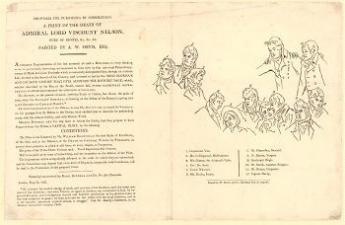Antiquarian Booksellers' Association
People, Prints and Progress â Or, Why are Prints Important?

By Jasper Jennings
First, the basics: a print is a repeatable image made by a variety of processes, usually on paper or fabric (sometimes other materials like treated animal skin). Ink is transferred from the printing surface – usually a metal plate, woodblock or limestone block – by exerting pressure, usually by means of a press.
The most widely practised traditional processes include woodcut and linocut, etching, engraving, lithography, and, in the 20th century, screenprinting.
One person’s idea of what constitutes a print is often very different to another’s. For much of my specialist period, the 18th and 19th centuries – much of it pre-photography – printing was the only medium of mass visual communication. So the prints I sell can be illuminating ‘primary sources’ for our history.
Of course I also appreciate the artistic qualities that many prints possess, and derive endless pleasure from the creative possibilities of printmaking. Printmaking produces aesthetic effects unrealizable by painting or drawing, and artists in Europe have been expressing themselves in print since around 1400.
Though relatively scant scholarly attention has been paid to the subject, I would go so far as to suggest that the printed image is at least as important as the printed word to the progress of Western civilisation. The major scientific and technological advances of the post-Medieval world would surely have been impossible without what William M. Ivins called the “exactly repeatable pictorial statement”.
Prints communicate ideas and information, and propaganda too. They can be purely decorative, or illustrative of text; many were intended to be bound into books of course. Before radio and television, prints were also entertainment in the home, for children and adults.
Because I’m a print dealer, I tend to think in terms of commercial categories – how the multifarious products of the printing press are categorized for offering to the market.
Generally something ephemeral like an 18th-century playbill is not strictly classed as a ‘print’ – though many print dealers, like me, also deal in items that are perhaps more properly described as ‘ephemera’.
Ephemera can be defined as the transient documents of everyday life, not expected to survive after their original purpose is served. If prints were the television and radio of their day, printed ephemera was perhaps Facebook, Instagram and Twitter. Highly mobile both in terms of where it was produced and consumed, it was not always printed in workshops or studios. Wherever people gathered in numbers – at a cricket match, say, or at a Frost Fair – portable presses in little tents printed souvenirs that are sometimes our most tangible connection with a historical moment.
As technologies improved, printing became an ever more versatile, responsive medium. Printing plates were passed from printer to printer, from engraver to engraver, often reworked several times. Impressions were printed off the same plate for years, decades sometimes, with layers of modifications reflecting changing times and changing tastes.
Prints have always been commercial propositions. In the 18th and 19th centuries there was big money to be made in reproducing paintings as prints. Enterprising publishers and printsellers commissioned paintings purely for turning into engravings, etchings etc. Or they sold, or took a share in, copyright to the pictures they bought. Some artists in turn made more from selling the rights to reproduce their work than from their original creations.
When they think of prints now people think of images produced by a printmaker by hand, rather than by mechanised mass-production or by photomechanical processes.
There was a resurgence in the later 19th century of the idea of the ‘original’ print, a design more-or-less conceived and produced by one and the same person, deliberately created as a print; not reproducing another artwork, the print is the artwork. What matters ultimately is artistic intention and effect. So prints tell us about ways of seeing and ways of living. For centuries before the photographer’s lens, people saw their world through prints.
***
Jasper Jennings is the owner of Jasper Jennings Antique Prints. Published on the ABA website, presented here by permission of the ABA. Pictures: the author. (1: Recycled woodcut used for a cricket poster, 1840s. 2: Proposal for subscriptions for the ‘Death of Nelson’ engraving after a painting by Devis, 1807).


